TO LEARN IS TO GROW
Learning Center
We do our research and publish our results. Should probably call this the Growing Center.


What Types of Content Do I Need For Each Stage of the Buyer’s Journey?
As a consumer, and especially when you aren’t familiar with a brand, you need to navigate through a process of information, research, and evaluation to decide to buy. That entire process is called a buyer’s journey; each stage has its objectives and your leads need to receive a certain type of information for each of its stages.
A great way to keep track of your prospects and leads is to know what stage they are in and speak to them accordingly. You are not going to succeed if you present yourself to someone who already knows your brand, or encourages a purchase to someone who is just getting to know you.
That is why you need to understand what does it mean when we speak about the stages of the buyer’s journey, so you can define the type of content you need to create for each stage.
So how does the buyer’s journey work exactly?
It is well known that a person ventures on his journey from an “unconscious stage”, except for impulsive purchases. There will be many people who have a first contact with your brand and fit the demographic of your buyer person, but are not yet familiar with your product or if they need it.
They need a trigger that impels them to have a pain point that can be solved by acquiring your product or service, and that is where the buyer’s journey begins.

What Are The Stages Within The Buyer's Journey?
First of all, you need to know which stages are there. To correctly define the buyer’s journey, you need to clearly understand your buyer personas, which are the semi-fictional characters of your ideal buyers .
You need to have a clear and complete understanding of your audience, to avoid creating a disconnect between your business and your potential customers. You need to create content that your readers and potential customers value and can find of interest.
In order not to waste time, money and effort, you need to understand your audience: know how they think, what information they are looking for and how they usually look for it to find a solution.
With this information at your fingertips, you can begin to define an effective content strategy for each of the various stages of the buyer’s journey.
This has to be the first step in developing the buyer’s journey and creating the content that has an effect on your buyer. Only then can you develop your marketing funnel and watch your buyer persona advance, thanks to the right content, at each stage of their journey.
The journey consists of a three-step process:

The Awareness Stage
The buyer is aware that they have a problem, a pain point, an opportunity, or a question that needs to be answered. Within this stage, your buyers will then do their own research online, hitting the search engines or social media channels to gain a better understanding of their problem or paint point.
The Consideration Stage
Within the Consideration Stage, the buyer now analyzes his problem and begins to investigate what options he has to solve it.
The buyer is committed to further research, as they now have a better idea of what it is they’re dealing with. As such, they are already looking into the best options available on how to address their problem or pain point.
The Decision Stage
Finally, within the Decision Stage, the buyer now chooses the solution to their problem. A decision has been made by the buyer, and so now they are actively looking for a vendor and supplier who can help them with their problem or pain point.

The Marketing Funnel and Its Three Stages
A marketing funnel, or sales funnel, presents the different stages that a prospect goes through before becoming a customer, from the first contact they had with the brand, and all their journey until they decided to buy.
The operation of the funnel is simple, just as a funnel works.
The top part refers to those who are further away from buying, and those who are closer to the funnel are closer to buying.
The marketing team is in charge of attracting your buyer persona to have the first contact with the company and start the first stage of their journey, and then deliver the qualified prospects to the sales team.
Once a prospect engages with you, your customer service team takes it upon themselves to delight them to build loyalty and make them not just come back to you again and again with repeat business, but also spread the word to become brand ambassadors themselves.
Bringing more folks to visit your business website helps fuel your sales and marketing funnel. Read “Increase Your Website Traffic: How Do I Bring in More Visitors To My Business Website?” for tips on how to generate more traffic

Which Content and Channels Are Best for Each Stage of the Buyer’s Journey?
Begin by embarking on the buyer’s journey and wondering how we can go about attracting and inviting this person to become a customer.
Getting business with the prospects you attract through inbound marketing is accomplished in three steps:
Attract strangers
Engage them and convert them into customers
Delight customers
As you create content, consider where you are on your journey and the best channels for sharing that content.
Thanks to the Internet, it has become easier to locate and engage customers and prospects in the various stages of their journey through content marketing. This is why content marketing is considered extremely important to an overall strategy.
That is why it is a challenge in which everyone must be in tune to create the right content, at the right time, for the right people.

Top of the funnel: discovery
This stage is aimed at the discovery, indirect customer acquisition, knowledge and presentation of the brand. We use the tactic of viral and educational content.
In this first phase of content marketing, the goal is to educate and generate brand awareness among potential customers.
Perhaps the need for your product is not immediately clear, so there, while presenting your brand, you also try to educate the market about the problem that your product or service can solve.
In this phase, content marketing is also used to generate interest. Not only does it help them to hear your name, they should also have enough interest and curiosity about your brand to remember it and begin to relate to it as a trustworthy brand.
While the ultimate goal is to convert, at the top of the funnel we avoid focusing content on just talking about the brand. Rather, we try to find out what the potential customer wants to know in order to present that content to them.
Type of content: videos, blog posts, webinars, complete guides, email newsletters, and other great content (games, tools, long-form content, parallax scrollers)
Channels: email marketing, blogging, search engine marketing, social media marketing
By doing this part correctly, the potential customer will begin to associate the brand with feelings of gratitude and respect, as well as authority on the subject.
Similarly, a double victory is generated because the competition and knowledge of your content consumers increases to a point where the products or services you have to offer are more useful to them.
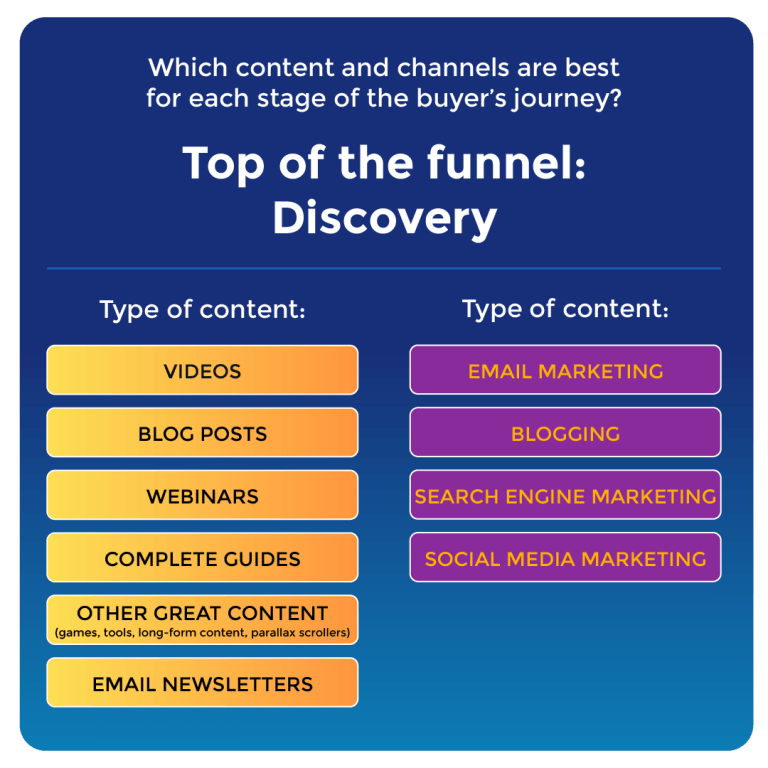
Middle of the funnel: consideration
At this stage, the objective is direct customer acquisition. We use the tactic of presenting solutions to use case challenges.
In the engaging phase, you want the potential client to start associating you with the solution you offer. Therefore, you need to provide them with content that makes it easier for them to evaluate your brand and your products.
At this stage, communication is directly with those people that our business can help and we show them how. It is very possible that they still do not trust the brand, so it would not be appropriate to sell them directly.
This stage is a great opportunity to ensure that the information that you present and differentiate yourself from your competitors is easy to navigate.
Type of content: case studies, instructional content showing your products, demo videos, product descriptions, and data sheets
Channels: email marketing, blog/website, webinars, retargeting/remarketing, social media marketing
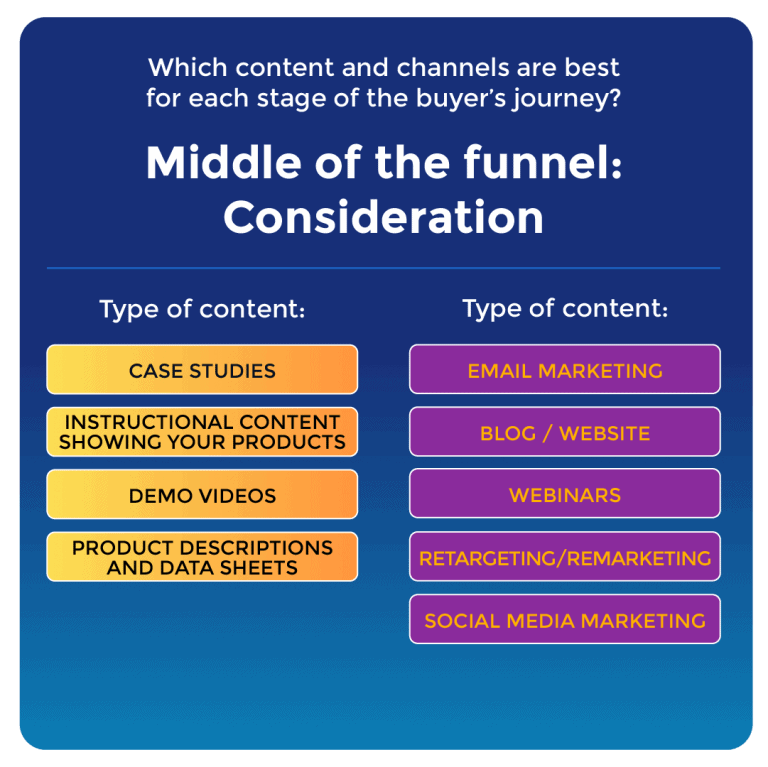
Bottom of the funnel: conversion
The objective of this phase is to generate transactions with customers. We use the tactic of product descriptions plus unique value propositions.
The previous stages prepared potential customers who, if they reached this stage, are ready to become customers.
Here the communication is direct and persuasive, but this also depends on the style of your brand (if the hard and direct selling works well for your audience).
This is the narrowest part of the funnel, as it is the point of transaction (or conversion) between the brand and the new customer. Whoever came here is interested in the brand and what it has to offer, so they need the last push to make the decision.
This type of content is simpler and very effective, where you can also include clear descriptions of your products that describe the unique value they provide to customers, as well as graphical graphics that compare your various products with each other or with those of other companies.
In this part of the funnel, the content that is presented is from content marketing sales.
Type of content: testimonials, reviews, an optimized, understandable, and reliable sales process
Channels: email marketing, retargeting/remarketing, social media
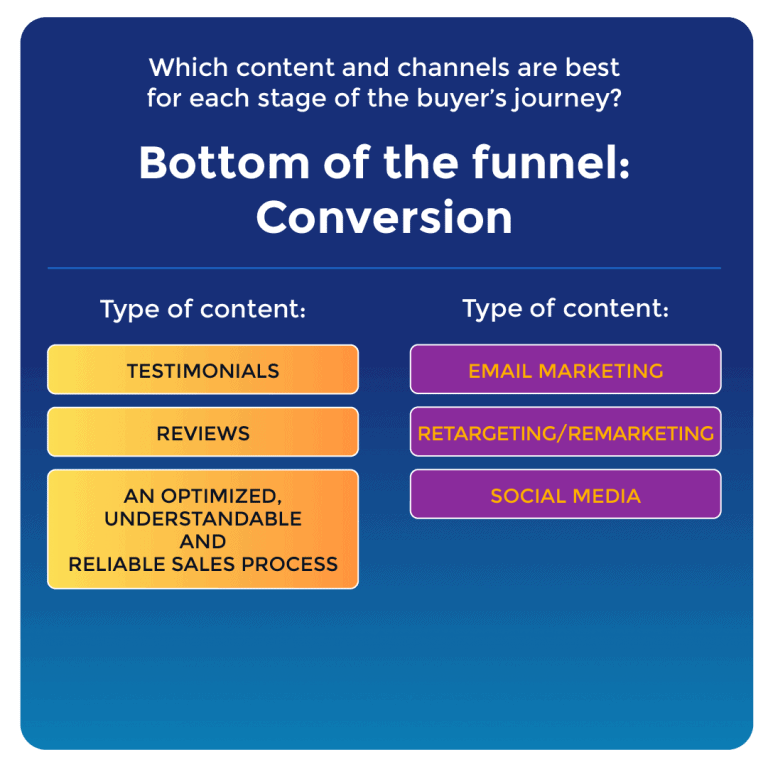
Beyond the funnel: retention
In this phase, the goal is to retain existing customers, and keep them satisfied. We use the help, support and onboarding tactic.
Once you’ve got those customers, you need to keep them. It is well known that it is easier to take care of your clients than to get a new one.
For this, it is also necessary that content marketing is part of that process. You should focus on turning unique buyers into repeat customers, and have them become ambassadors or spokespersons for your brand.
Type of content: friendly customer support, help documentation, effective product UX, special and tailored offers, dissemination and follow-up by email, insider how-to-do’s.
Channels: email marketing, retargeting/remarketing, self-service channels such as knowledge bases, live chat and chatbots for customer service, loyalty programs
Creating market-specific content for each stage of the buyer’s journey is a key concept of an effective content marketing strategy. Read our article, “9 Things You Can Do To Help Jumpstart Your Business” for more tips on how to give your business a much-needed headstart.
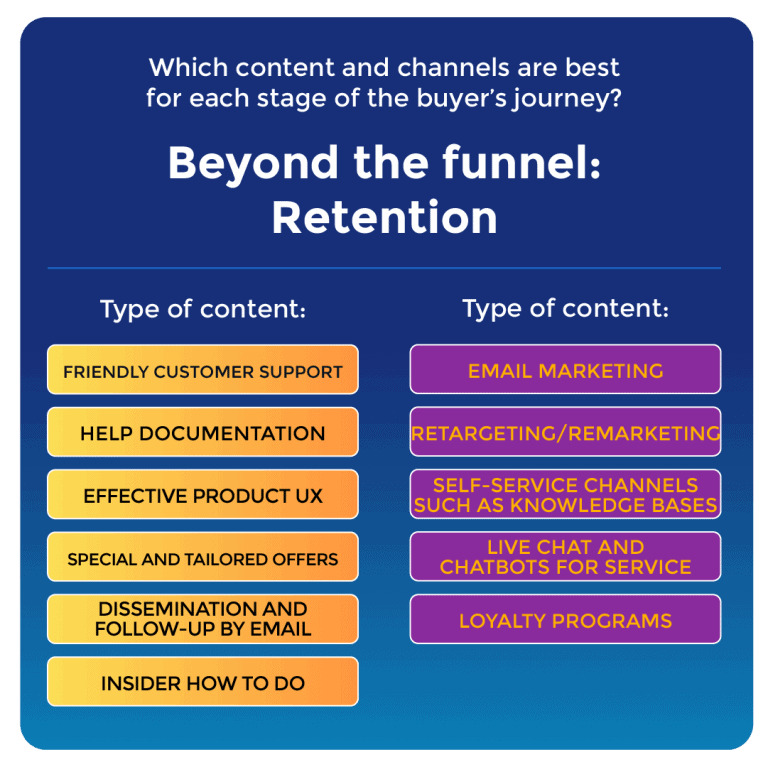
From Funnel to Flywheel
The funnel model of marketing describes the customer’s journey as they learn more about your business and eventually complete a purchase.
Businesses have utilized the funnel model for years, evaluating customers at certain stages of the funnel to better understand what they should do in order to influence the customer’s purchase decisions.
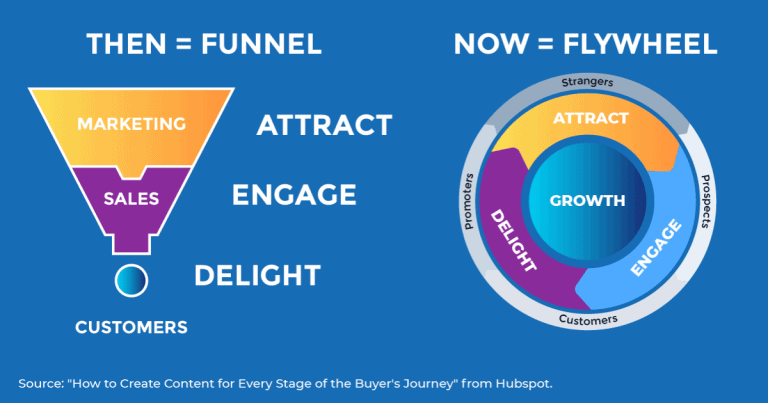
While the marketing funnel is effective in its own right, customers have grown past the linear strategy of going through the awareness and interest stages before considering a product.
In today’s marketplace, getting a customer to purchase your product shouldn’t be the end goal anymore. A successful marketing strategy can also turn your customers into effective promoters of your business.
The flywheel model attempts to improve the marketing funnel by giving more focus to the customers’ overall role in the purchase process. While a funnel looks at securing customers as the final outcome, a flywheel aims to produce happy and satisfied customers that it can also use to boost brand recognition and further grow the business.
In a flywheel model, customer experience is the main priority for every stage. The main objective is to produce loyal customers that help market the brand through positive personal experiences, including them in the growth cycle of the company.
A Final Word About Content For The Different Stages of The Buyer's Journey
As part of your overall digital marketing strategy, your team should be aware of the different stages of the buyer’s journey, and then develop the right kind of content for these stages.
It might take a lot more work, but in this manner, you are able to get more qualified leads and even an increased likelihood of repeat business from your delighted customers.
Take stock of what you and your team can realistically put together for your content marketing efforts. And if you need any additional help with your marketing, get in touch with our scrappy team of digital marketers at LOJO– we’ll be more than happy to figure things out with you and come up with an awesome marketing campaign for your brand.
Built for Growth. Backed by 25 Years of Trust.
For over two decades, LOJO has been a trusted partner to hundreds of businesses just like yours. Whether working directly with owners, managers, teams, or boards of directors, our goal remains the same: to be a reliable and results-driven asset to your business.
Over the years, we’ve carefully built a team of experts—each selected for their unique skills, strengths, and personalities. Our clients choose LOJO because they know we genuinely care about their success.
And after 25 years of helping businesses grow, we’re more committed than ever.
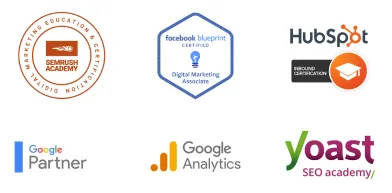
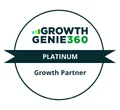
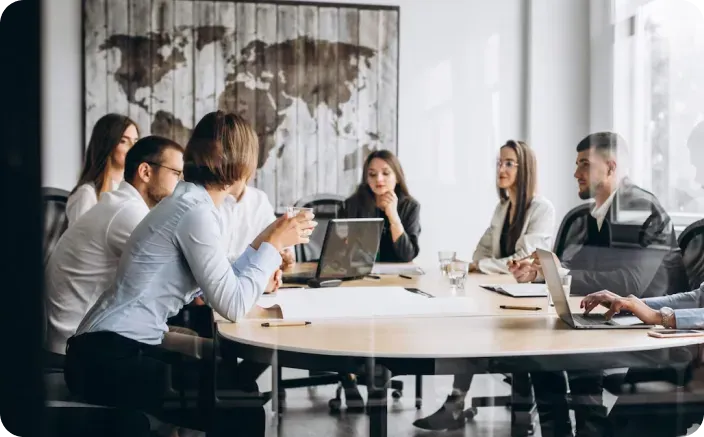
Built for Growth. Backed by 25 Years of Trust.
For over two decades, LOJO has been a trusted partner to hundreds of businesses just like yours. Whether working directly with owners, managers, teams, or boards of directors, our goal remains the same: to be a reliable and results-driven asset to your business.
Over the years, we’ve carefully built a team of experts—each selected for their unique skills, strengths, and personalities. Our clients choose LOJO because they know we genuinely care about their success.
And after 25 years of helping businesses grow, we’re more committed than ever.



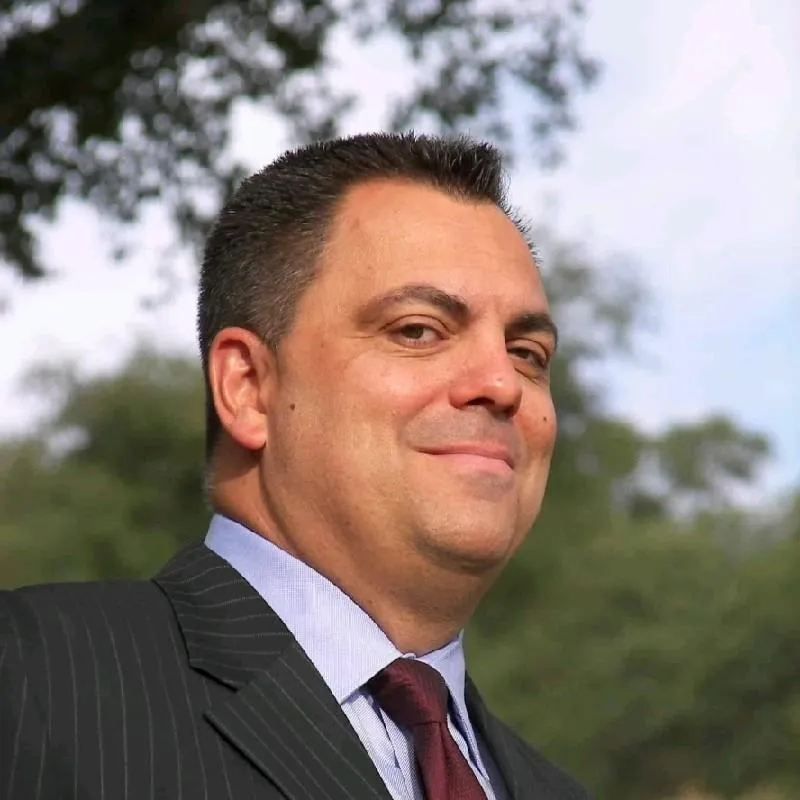
Matthew Rogers, President
iProspect Check
After spending several months reviewing multiple proposals from several different companies we engaged LOJO to develop a new website that represents our company effectively. We worked initially with Stephen Platte who helped create the scope of the project. Stephen was knowledgeable and always followed up with me on time and as promised.
He "closed the deal" for LOJO with his professionalism, service orientation and easy going approach. Once we signed the contract we were introduced to Jay Kelly who would be the creative lead for LOJO. This was the most challenging part of the project for my company, as there was no shortage of ideas from our side. Jay managed the project flawlessly, and once we had all agreed to the design, Jay introduced us to Eric.
Eric Lay is one of the founders of LOJO. Eric took the design we had developed and brought it to life. We delivered content as quickly as he requested it. Eric kept the project on task and we responded by exceeding every deadline for content. In turn, once provided, literally not a day went by that Eric didn't add the content and take the next step. In just a few weeks we launched our new website. Eric is a pleasure to work with.
His positive attitude and consultative approach really enhanced the experience and made a big difference for us in the outcome of our project. We would welcome you to visit our website to take a look at the quality work of LOJO. We are very pleased with LOJO and look forward to working with them in the future as we pursue an aggressive SEO strategy."
After spending several months reviewing multiple proposals from several different companies we engaged LOJO to develop a new website that represents our company effectively. We worked initially with Stephen Platte who helped create the scope of the project. Stephen was knowledgeable and always followed up with me on time and as promised.
He "closed the deal" for LOJO with his professionalism, service orientation and easy going approach. Once we signed the contract we were introduced to Jay Kelly who would be the creative lead for LOJO. This was the most challenging part of the project for my company, as there was no shortage of ideas from our side. Jay managed the project flawlessly, and once we had all agreed to the design, Jay introduced us to Eric.
Eric Lay is one of the founders of LOJO. Eric took the design we had developed and brought it to life. We delivered content as quickly as he requested it. Eric kept the project on task and we responded by exceeding every deadline for content. In turn, once provided, literally not a day went by that Eric didn't add the content and take the next step. In just a few weeks we launched our new website. Eric is a pleasure to work with.
His positive attitude and consultative approach really enhanced the experience and made a big difference for us in the outcome of our project. We would welcome you to visit our website to take a look at the quality work of LOJO. We are very pleased with LOJO and look forward to working with them in the future as we pursue an aggressive SEO strategy."

Matthew Rogers, President
iProspect Check
The team at LOJO were wonderful to work with. They are well organized and very patient as we worked through our marketing strategy and developed a well thought out and clear action plan at a reasonable price. We will definitely be back for our future campaign needs."
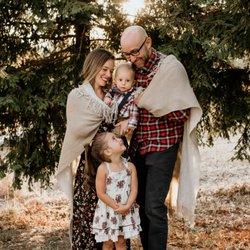
Jon Crosby, Founder
Dazil

